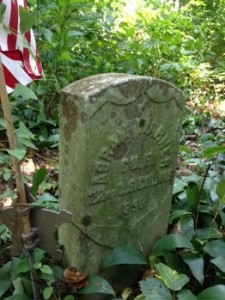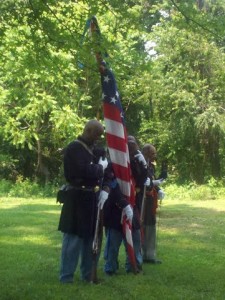Pennsylvania’s hallowed ground: A role for historic preservation
06 November 2015 – Brenda Barrett
preservation, community history, race, The Public Historian, National Historic Preservation Act, National Historic Preservation Act commemoration, American Civil War
Editor’s note: This post continues a series commemorating the anniversary of the National Historic Preservation Act by examining a past article published in The Public Historian, describing its significance and relating it to contemporary conversations in historic preservation.
The saga of the Locust Grove Cemetery, an African American burial ground in the small borough of Shippensburg, is one that is repeated across the commonwealth of Pennsylvania. In his article, “’From Troubled Ground to Common Ground’: The African-American Cemetery Restoration Project: A Case Study of Service-Learning and Community History” (2008), Steven Burg recounts his work with students to research and tell the story of the cemetery’s historic value and engage with its caretakers in the site’s preservation.1 The Locust Grove project helped change the community’s perception of the cemetery from problem property to a respected historic site. While it was a success on many levels, the Locust Grove project highlights the challenge of using the National Register of Historic Places as a preservation tool.
Let me confess that I am not a disinterested bystander on this issue. For the last several years, I have volunteered with the Hallowed Ground Project, a small group dedicated to conserving and honoring the burial sites of Pennsylvania’s United States Colored Troops (USCT). There are special challenges faced by those who care for African American cemeteries, which are highlighted in the work at Locust Grove and at cemeteries that are similarly situated across the state.
The Hallowed Ground Project was founded to pick up the pieces from an earlier effort begun as part of Pennsylvania’s commemoration of the 150th anniversary of the Civil War. In 2008 the state tourism program launched a number of innovative strategies to reach new audiences. To spotlight the contribution of the state’s African Americans, they sponsored research to identify USCT veterans from the state’s muster rolls and then sought out the USCT cemeteries as possible tourist attractions. This work identified 42 such cemeteries, but they were far from visitor-ready. Many of the sites were in disrepair, located in areas without any descendant population or where the caretakers were growing older and had limited resources. Others were totally forgotten and abandoned. By 2010, Pennsylvania had elected a new governor, and state interest in the USCT cemetery project evaporated.
It is almost always the first step in starting a historic preservation project to seek recognition of the property’s historic value. In Pennsylvania, as in most states, the gold standard for historic significance is listing on the National Register of Historic Places, the official list of the nation’s historic places worthy of preservation, as authorized by the National Historic Preservation Act of 1966. However, for Burg and his students or the Hallowed Ground Project’s cemetery conservation efforts, there is a problem. The implementing regulations specifically state that “ordinarily” cemeteries do not meet the criteria for listing in the National Register of Historic Places unless they meet the additional requirements detailed in National Register Bulletin 41 on Evaluating and Registering Cemeteries and Burial Places.
As part of the preservation initiative for the Locust Grove Cemetery, Burg’s classes began determining the property’s eligibility for the National Register, in part to qualify the cemetery for possible state grant assistance. It was hoped this could open the door to funds to restore the cemetery. Plus, it would afford the cemetery some protection from federal or state projects like road widening. The good news was that the State Historic Preservation Office determined that the Locust Grove Cemetery was potentially eligible for National Register status. However, the information requested to prepare a full nomination was extensive. It included preparing a context on the growth and development of the local African American community, a comparison to other African American cemeteries in central Pennsylvania, and an analysis of their role in their communities. To date, the nomination has not moved forward; though Burg and his students were able to convince the state to install a historical marker.

United States Colored Troops marker, Conestoga Cemetery, Lancaster County, PA. Photo credit: Brenda Barrett
Drawing from Burg’s article and my own experience, I want to talk specifically about the challenges of evaluation and designation of African American cemeteries. Unlike issues such as historic preservation grant funding or the political vagaries of state tourism programs, we as historic preservation practitioners can do something about this issue. What better time than the 50th anniversary of the program to welcome inclusive participation in the National Register and to examine barriers that place nominations like the Locust Grove Cemetery on hold? What can state and national preservation programs do to recognize the historic resources of under-served communities such as Pennsylvania’s African American cemeteries? Some suggestions:
- Recognize the defining characteristics and significance of these places. The 42 African American cemeteries with USCT burials in Pennsylvania reveal a landscape of segregation and marginalized locations, as well as a story of patriotism and the veterans who left a record of service. Historically, many African American communities had limited economic resources, and the only tangible remains are the cemeteries. While some may be overgrown or hard to read, they have strong spiritual and patriotic, as well as historic, association for members of the community.
- Develop a statewide historic context for African American cemeteries. Preliminary research on Pennsylvania cemeteries with USCT burials shows a very different picture than the history of Pennsylvania cemeteries that is provided on the state website, which starts with colonial graveyards and then jumps to park-like designed cemeteries. Another state web resource on black history is informative but does not address cemeteries or burial practices. Preparing a historic context for these cemeteries would help recognize this important part of our past without the burden of developing time-consuming justifications for every individual nomination.
- Ask the National Park Service to consider updating Bulletin 41 to provide guidance that reflects a more updated understanding of African American cemeteries. The National Register program has done a good job in addressing the topic of diversity through such initiatives as the American Latino Heritage Projects and African American Heritage. This could be an added initiative.
All of these steps would make it easier to evaluate the historic significance of these resources and help them gain the benefits of listing in the National Register of Historic Places. Then, cemetery caretakers across Pennsylvania can focus on the more pressing problems of acquiring clear title to their property, repairing broken headstones and sunken vaults, and engaging additional partners in the unending maintenance needs of these hallowed grounds.
~ Brenda Barrett is the editor of the Living Landscape Observer, an online site that provides information and commentary on the emerging field of landscape-scale conservation, historic preservation, and sustainable communities.
1 Historic Site Report on the Locust Grove Cemetery





A major, major USCT research tool has just been added to the Camp William Penn website. Every USCT soldier of the Camp William Penn regiments has his own computer folder, 18,000 folders, 400,000 documents. Every soldier’s military file. A major new development in USCT genealogical and historical research.
Please click on File Archive on the following website.
CROHL – Civil War Directory – Google Drive